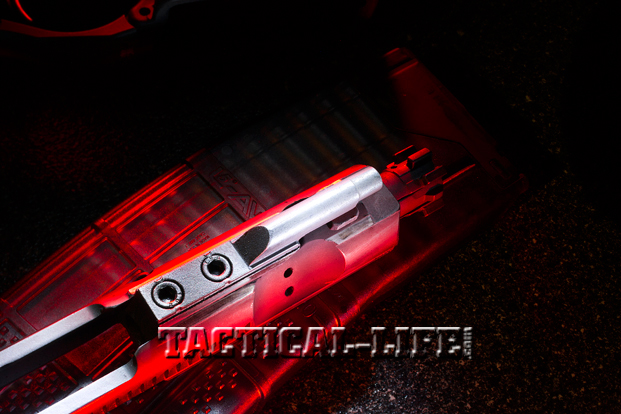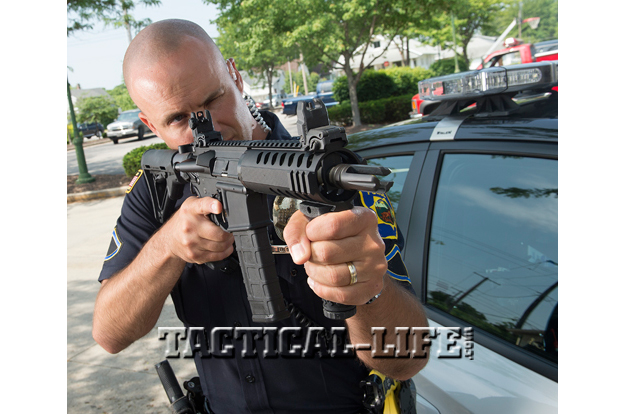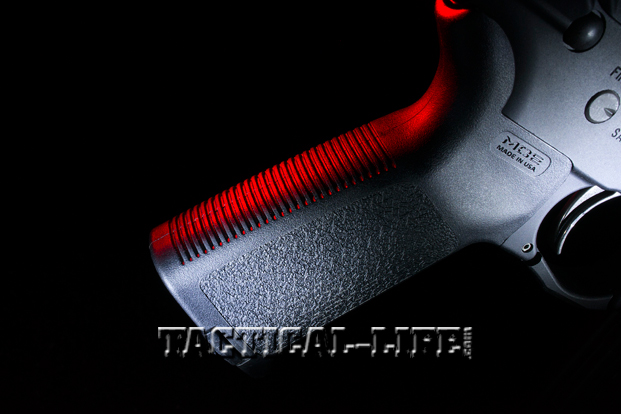The compact 5.56mm DPMS RFA3-PDW offers LEOs power and accuracy to gain the edge in tight quarters. Shown with an Aimpoint Patrol Rifle Optic.
Combining the short overall length of a pistol-caliber submachine gun with the power and performance of a traditional rifle, the “personal-defense weapon” (PDW) has been gaining steadily in popularity in the law enforcement community in recent years. Merging compact handling characteristics with the power to penetrate body armor or barriers as well as reach out a few hundred yards if necessary, they offer an appealing combination of qualities.
It’s easy to associate the PDW with military applications. The increase in private security details, especially overseas, has opened up a weapons market beyond what might have ever been seen, if not for such tailored operator requirements. There are, of course, private security details here in the U.S. Dignitaries and even local politicians, such as mayors and senators, are known to have significant protection forces for them. So, a domestic market for these compact weapons has also developed.
Advertisement — Continue Reading Below
Although the PDW is not a new concept, its popularity has grown significantly within the past five years or so. PDWs are small, as they should be, so that they can be concealed if desired. Less physical weapon size offers many benefits. A smaller size is desirable when operating in and around vehicles, for obvious reasons. Longer barrels can get caught on everything as you maneuver. Operating in tighter confines is also less of a chore with these smaller-sized weapons.
In the past, gaining these handling advantages required that you trade off the ability to fire a high-velocity rifle cartridge and employ either a pistol or a pistol-caliber submachine gun. However, the PDW concept sidesteps this issue entirely. No longer do we have to give up high velocities for weapon size. Some still think that shorter barrels mean less accuracy, but that’s been proven to not be the case. So these weapons really can make sense for certain missions. And, these have translated very well over to LE applications.
Specifically, the PDW can be a positive fit for patrol officers as well as SWAT/tactical officers. For patrol officers, it offers increased terminal performance over their service pistols. Its reduced size also offers an improvement in deployability, from already cramped and overfilled vehicles. And, let us not forget the improved accuracy of a shoulder-fired weapon. For the tactical team member, you get a submachine-gun-sized package capable of firing projectiles with impressive velocities.
Advertisement — Continue Reading Below
The quarters in which many tactical teams are forced to work in are extremely close. Most engagements occur in across-the-room or hallway-length distances, so maximized maneuverability doesn’t hurt. With the proper ammo, a 5.56mm projectile can still be running at 2,200 feet per second (fps) out of a PDW’s barrel. The PDWs smaller footprint means less bulk and weight, and overall, less gun to deal with when you are already kitted up to the max.
Many agencies currently field some sort of AR-15 platform, so transitioning to an AR-based PDW would require minimal training. Although many teams currently employ Heckler & Koch MP5 9mm submachine guns as their entry guns, they often also use AR variants in other roles, meaning there is built-in familiarity with the platform.
Gun Details
I recently had the opportunity to try out an exciting AR-based PDW from DPMS, a company known for providing high-quality weapon systems at reasonable prices. This weapon, the 5.56mm RFA3-PDW, is an AR-based PDW that was developed as an enhanced version of DPMS’ previous “Kitty Kat” model. The RFA3-PDW represents DPMS’ commitment to offering a top-tier short-barreled rifle (SBR) platform.
Advertisement — Continue Reading Below
The RFA3-PDW features an extremely short 7-inch barrel that is chrome-lined and has a heavy contour. The barrel is manufactured from 4150 chrome-moly steel. The diameter of the barrel is 0.85 inches. Though the barrel is short, it has some heft to it. The RFA3-PDW also features a direct gas impingement system of operation, so those familiar with the standard AR will be right at home with the operating system.
Unlike the Kitty Kat, which features a simple round aluminum handguard, the RFA3-PDW has an extended custom-railed handguard that is free-floated. The low-profile gas port, under the handguard, means you have extra real estate for mounting accessories like lights, lasers and grips. You need not worry about a forward grip, either, as DPMS provides the RFA3-PDW with a SOG vertical foregrip already attached to the bottom rail of the handguard. You’ll definitely want this or some other brand of grip when using this weapon to help ensure you keep your hand out of the path of the short muzzle.
There is a rail along the entire length of the top of the handguard. The top rail mates up with the A3-style flattop rail of the PDW’s upper receiver, which is manufactured from forged 7075-T6 aluminum. The lower receiver is also manufactured from 7075-T6 aluminum. Adorning the top rail is a set of Magpul MBUS folding backup sights. On each side and bottom of the forend are short rail sections for attaching accessories as well as the included foregrip. The pistol grip on the RFA3-PDW is a Magpul MOE, and the buttstock is the standard collapsible M4 type. The bolt is mil-spec, Carpenter 158 steel, and the bolt carrier is made of 8620 steel and has a properly staked gas key.
Advertisement — Continue Reading Below
The gun weighs in at a feather-light 5.5 pounds, and its overall length ranges from 23.75 inches with the stock collapsed to 27.75 inches with the stock fully extended. As with any standard AR-based weapon, all the controls—from the safety to the magazine and bolt releases to the charging handle—are all in their familiar locations.
Range Time
Although the RFA3-PDW is offered as a complete weapon, I only needed the upper receiver for testing. I already had a select-fire DPMS lower receiver waiting to be joined to it. I inspected the gun and then headed out to range for testing at 50 yards, considering the PDW’s likely intended role.
Advertisement — Continue Reading Below
I quickly found that the RFA3-PDW ran extremely well. Some ultra-short ARs with direct gas impingement systems can be finicky about running well, but my test sample proved to cycle quite reliably. The gun was very comfortable to shoot, and during testing, empty casings fell in the 3 to 4 o’clock range. It was clear that the gun was “gassed” correctly.
Not knowing what to expect, I was very pleasantly surprised when the RFA3-PDW shot a 0.69-inch group with Silver State Armory 45-grain Barnes TSX ammo. Also impressive was the Black Hills 60-grain V-MAX ammo, which created a best five-shot group measuring 0.75 inches. Also worth noting is the Silver State Armory 64-grain PPT Bonded, a heavier, barrier-penetrating round that may be of interest to LE agencies. It printed a 0.87-inch five-shot group. It’s safe to say that the RFA3 shoots accurately enough. Over 200 rounds were fired through the weapon in both semi- and full-auto modes, and no malfunctions were incurred.
Terminal performance is important. When a weapon is both accurate and reliable, the only thing keeping it from being a viable choice is terminal performance. There’s no way around it: You’re going to give up significant velocity with a barrel shorter than 16 inches. If you take notice of the performance chart, you’ll see respectable velocities coming from the 7-inch barrel at the muzzle.
Advertisement — Continue Reading Below
However, I was curious as to the performance closer to the target. In order to find out, velocities were checked on a few random loadings at 50 yards. The Silver State Armory 45-grain Barnes TSX ammo was clocking at 1,934 fps, Black Hills 60 V-MAX at 2,042 fps, and Silver State Armory M885 at 2,147 fps at that range. Between the three, the average drop in velocity was 113 fps at 50 yards.
Final Thoughts
While velocities and bullet weights are often presented as a concrete testament to real-world efficacy, real efficacy comes from placing shots quickly and accurately. Due to the DPMS RFA3-PDW’s size, target acquisition is quick, and with its ability to drive rounds on target, it should give its operators confidence that threat incapacitation can be effectively achieved.
Advertisement — Continue Reading Below
For officers looking for a weapon system that offers operational familiarity through the widely used AR configuration, but in a pint-sized package that still retains the power of the 5.56mm round, then the DPMS RFA3-PDW is just about an ideal solution. From its high quality to its impressive performance to its reasonable price point, the RFA3-PDW definitely deserves a close look from you and your department. For more information, visit dpmsinc.com or call 320-345-9223.








































